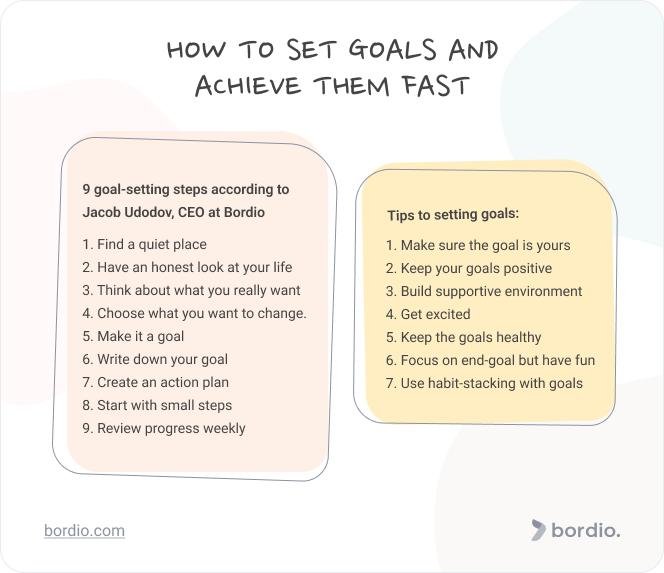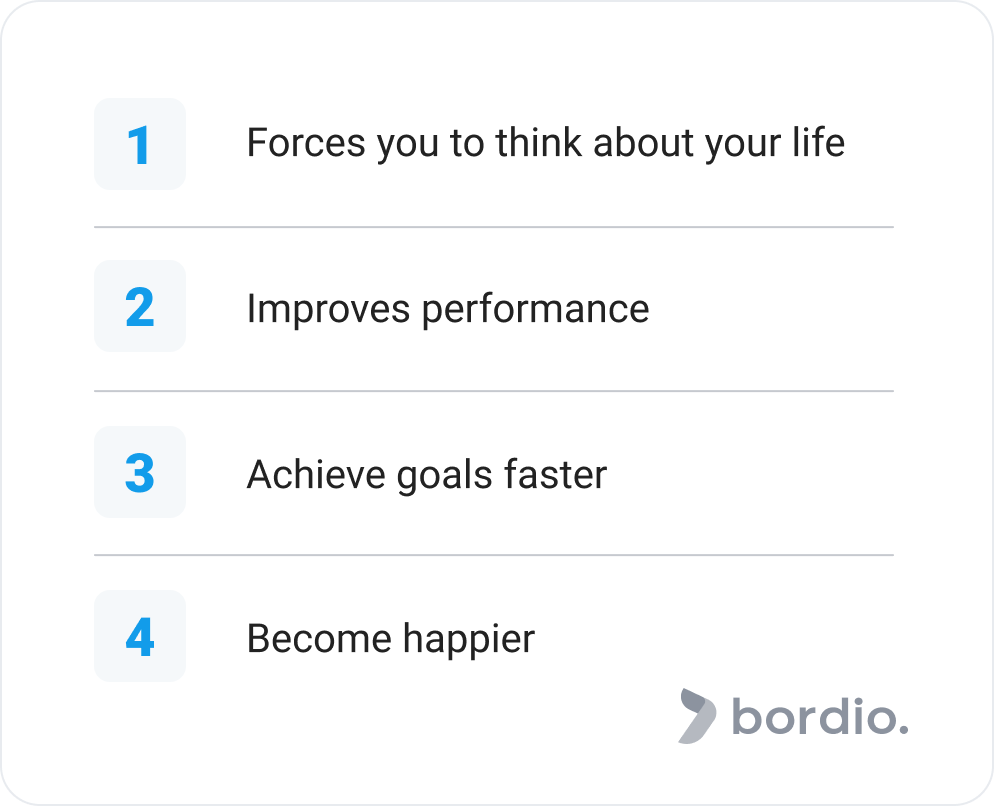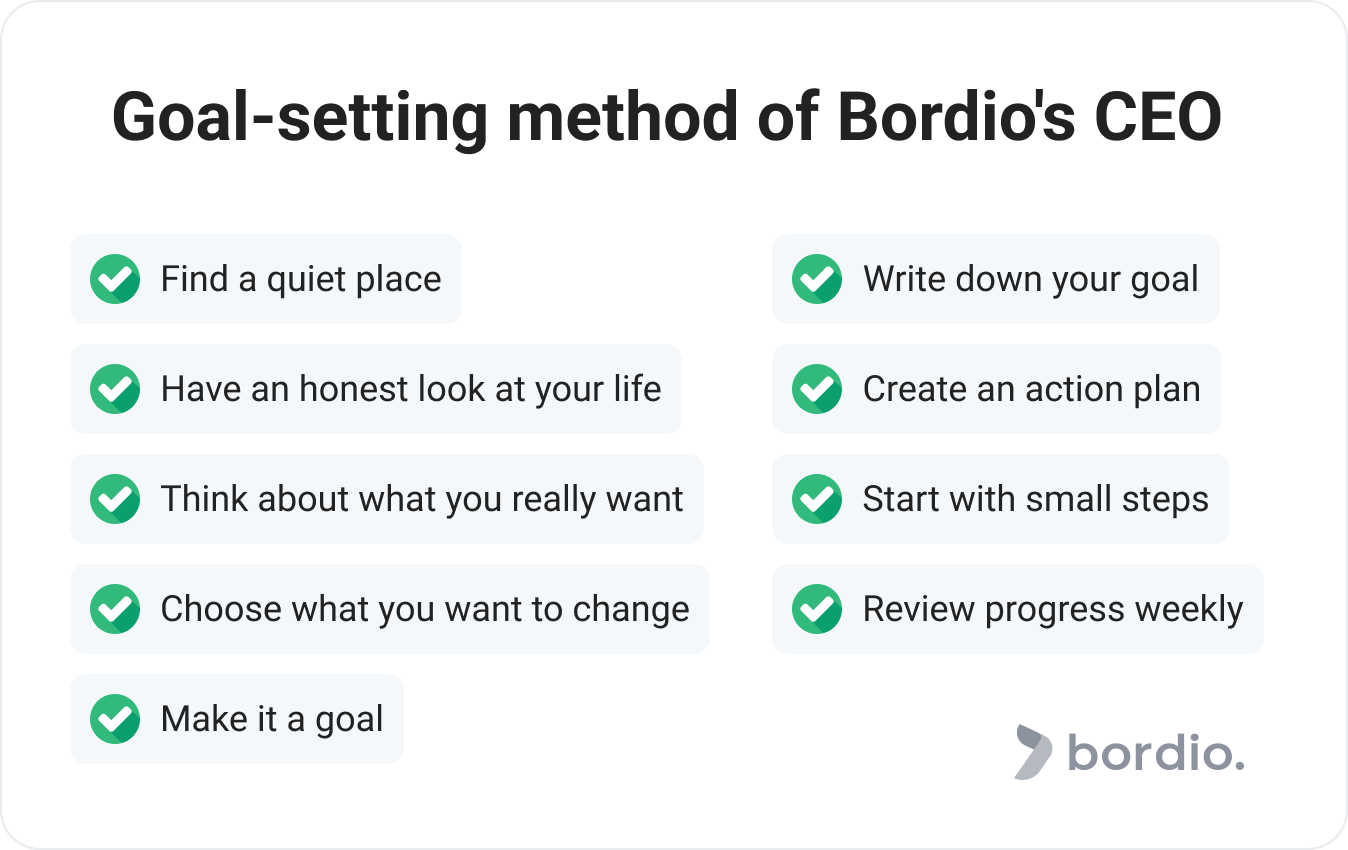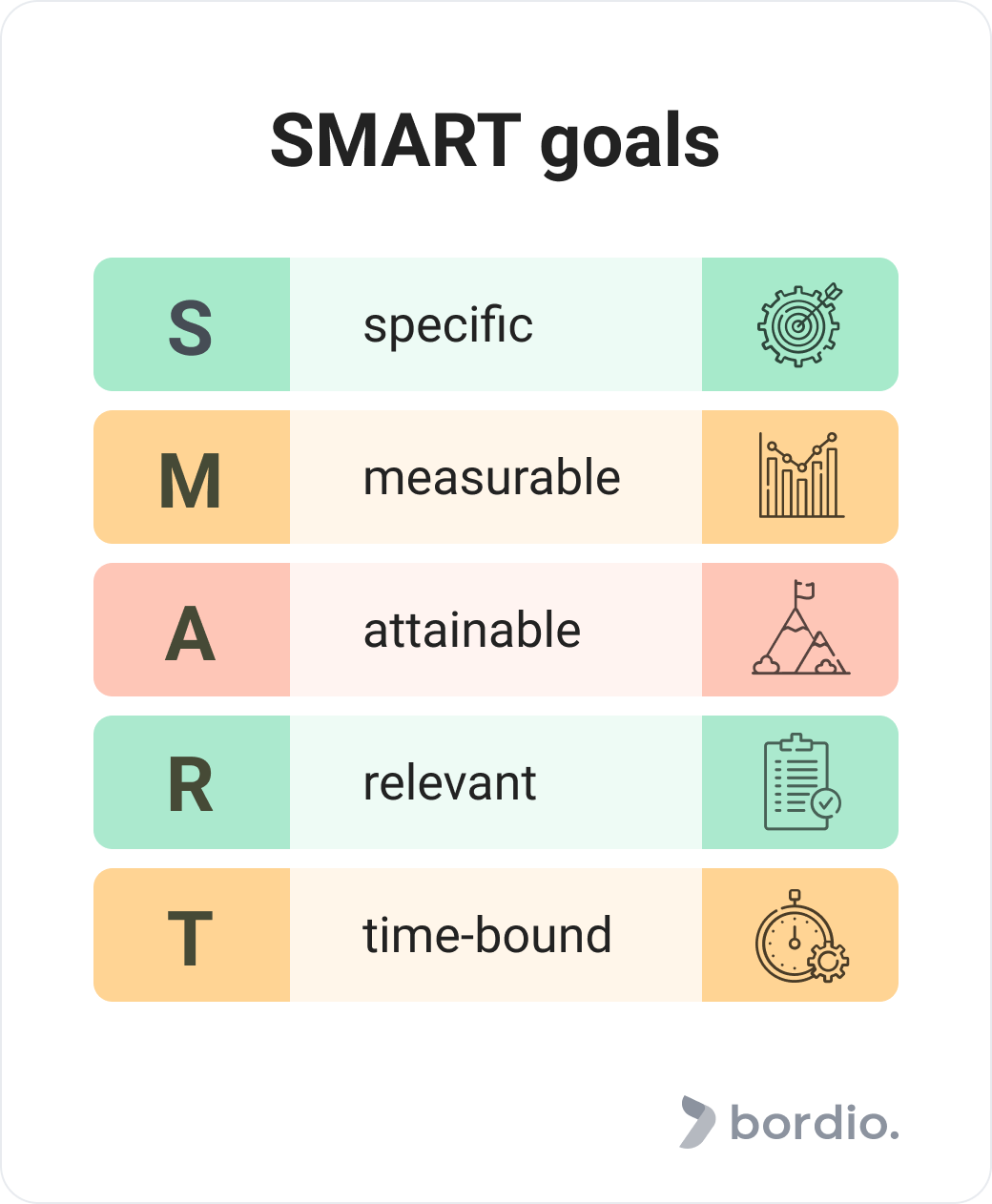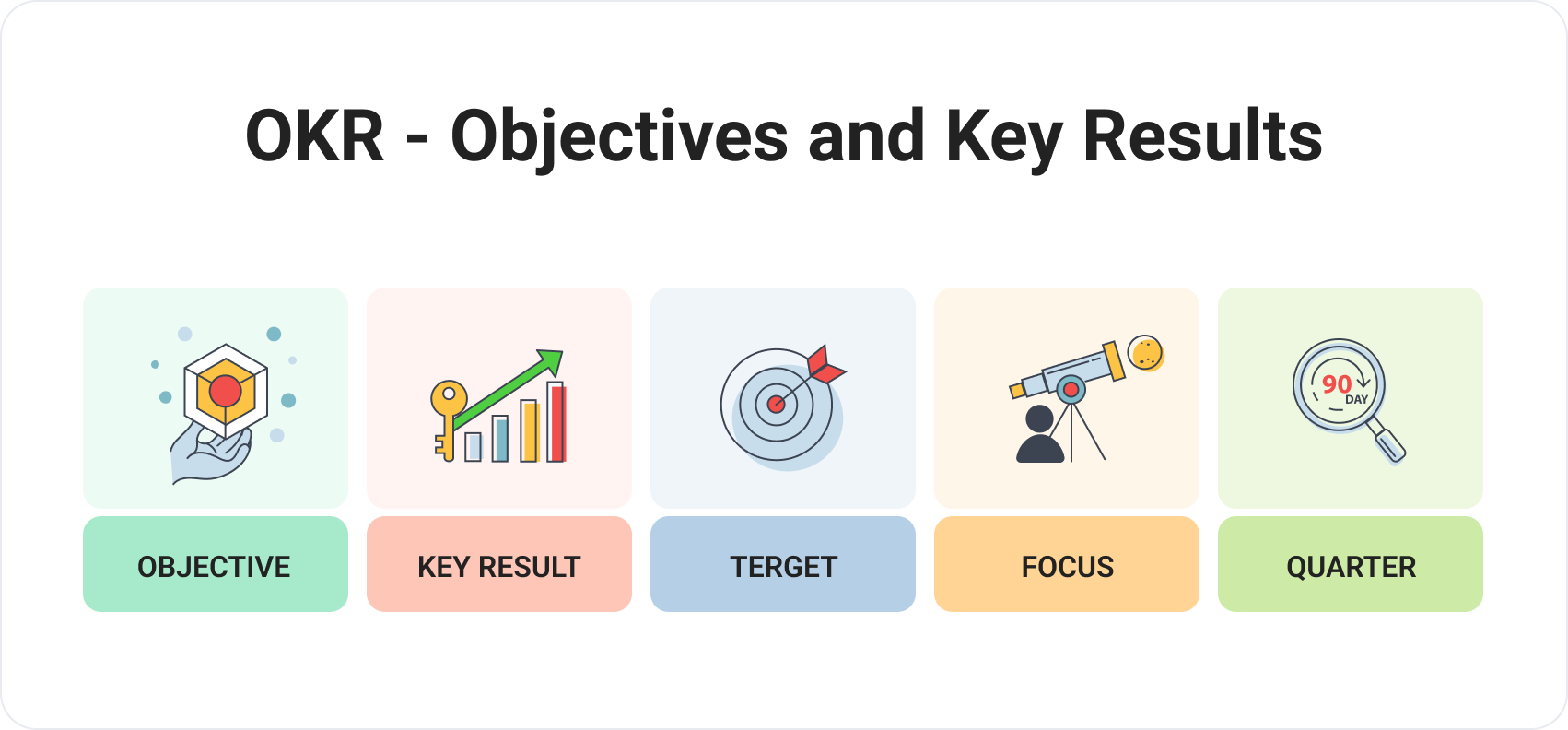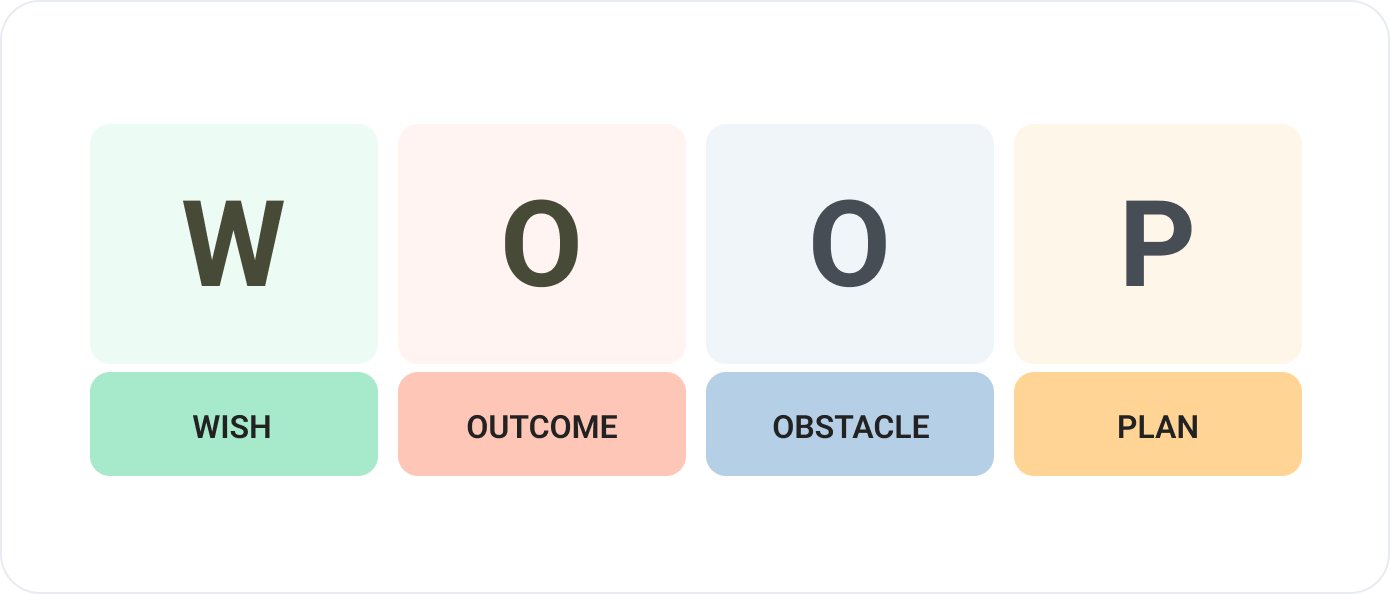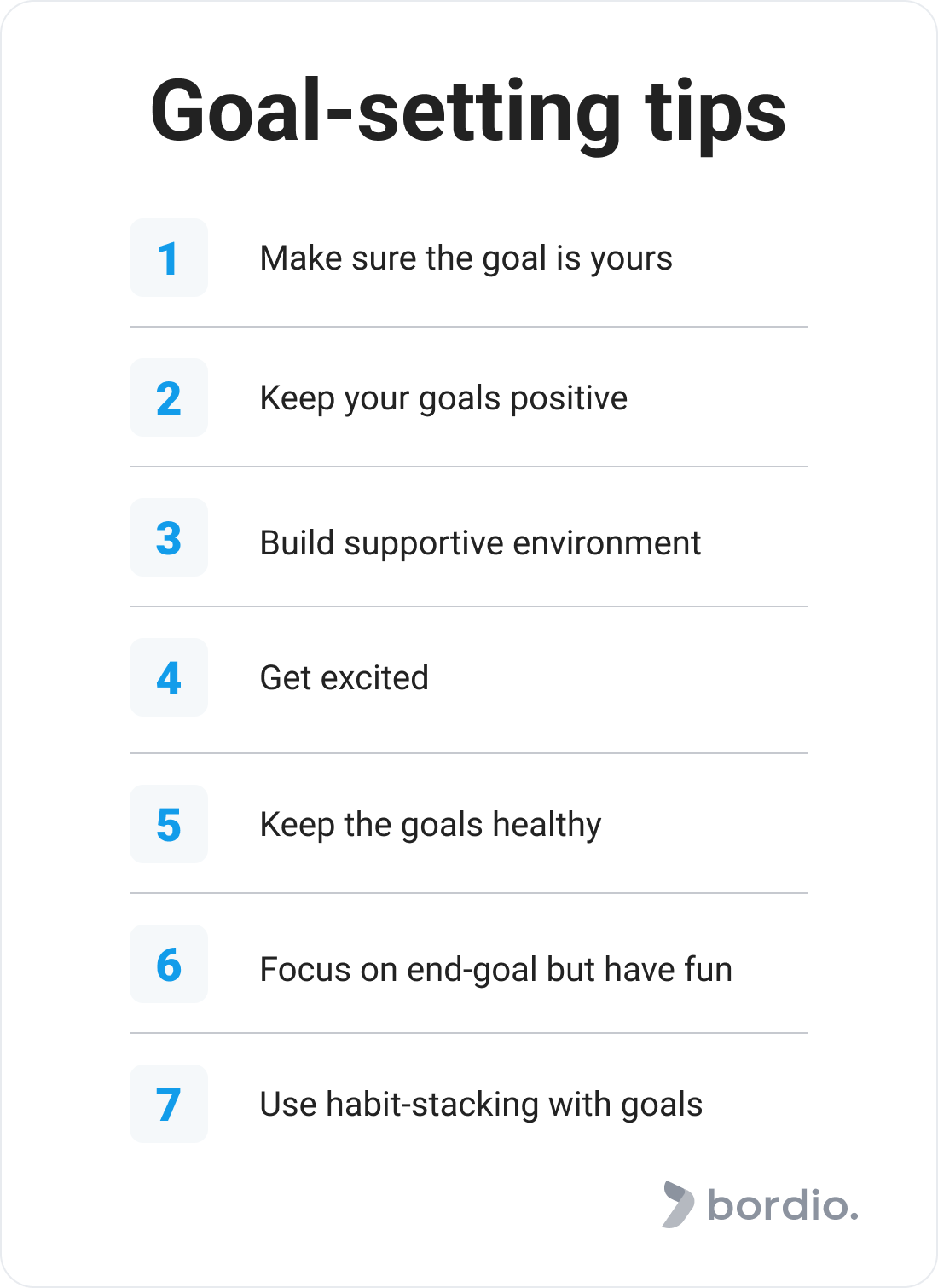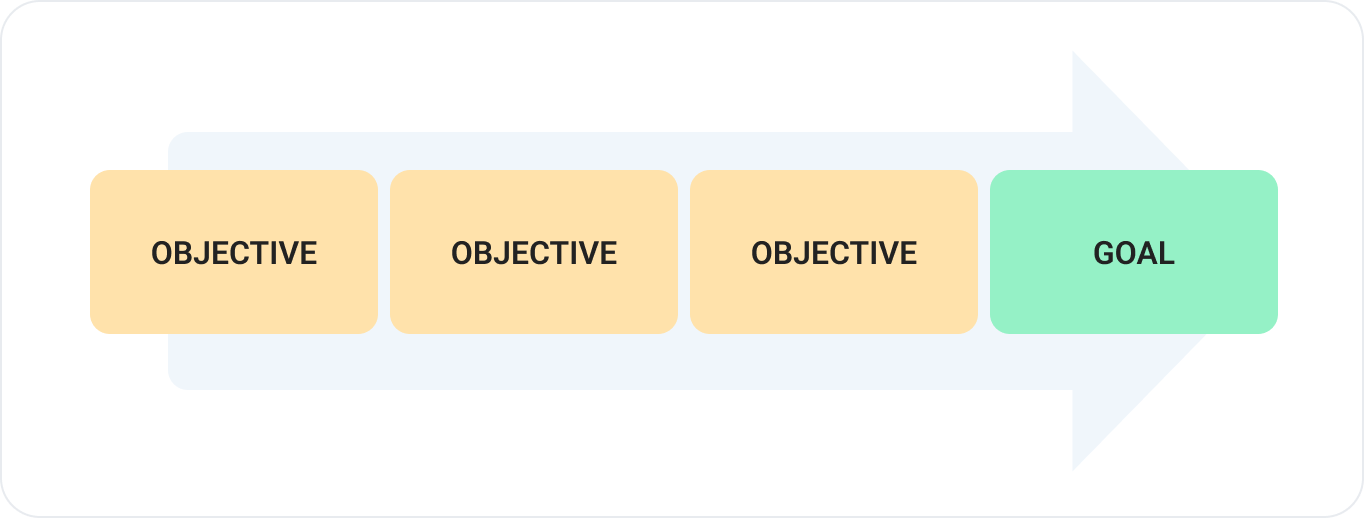Every one of us has goals that we want to achieve. Goals may be different, but they all share the same mechanic. Whether you dream about becoming the next Picasso, leading the global sales department, having a million dollars in your bank account, or inventing a new medicine, the steps you should take to reach those goals remain the same across all boards.
In today’s article, we will share the key steps you need to take in order to bring yourself closer to your goal. We will also talk about common mistakes and bottlenecks and how to avoid them.
If you want to become the best version of yourself and finally make all your dreams come true, then keep on reading!
What is goal setting?
Goal setting is the process of deciding on specific objectives that you want to achieve.
You can have goals about anything in life: work, hobbies, relationships, finances, physical health, academics, etc. Goals can be short-term (with a deadline in a month) or long-term (a few years from today).
Why is goal setting important?
At Bordio, we encourage everyone to set life goals because:
- Setting personal goals forces you to think deeply about what you want to do with your life. Aimless drifting is fun sometimes, but we need goals to give us direction.
- Setting goals improves performance. You get a better outcome in the end if you’ve dedicated time to think through your goals and the steps you need to take to achieve them. If you don’t think about it, you can still end up achieving goals to a point, but you’re likely to be far less satisfied with them.
- Goal setting means you achieve goals faster. The process of reaching goals, whether small or lofty, is more efficient with goal setting and planning, so you end up reaching whatever it is you desire in a shorter period of time.
- When you create goals and achieve your goals – you become a happier human being. There is something magical about achieving goals that don’t compare with other life pleasures that we have access to.
How to set goals using Bordio’s CEO technique
Jacob Udodov, the CEO at Bordio, is an avid goal-setter. For this article, Jacob agreed to share his signature goal-setting technique that helps him achieve the majority of the goals that he sets for himself.
Step 1: Find a quiet place
Find a spot where no one will disturb you, and give yourself at least two hours.
You will need a notebook or a pen and a piece of paper.
Goal-setting is not “just another task from your to-do in time planner“. Your goals have a direct impact on your future, so it’s important to set the goals consciously. It’s great if you can set your goals when you are on vacation because then you are out of your routine and can look at your life from the side and analyze it with less bias.
The most creative ideas that we have usually come to us when we step out of our routines.
Step 2: Tell yourself (honestly) where you are right now
When you are in a quiet place with your mobile phone turned off or on DND, start looking back at your life.
You can do this out loud too. For example: Today I’m 27 years old, I have a family and one kid. I’m living in a house I’ve built, which I also enjoy. I’m running two businesses, etc.
Be honest with yourself. Think about what you like about your life (your current situation) and what you don’t. For example, you can say: I don’t like the district I’m living in, I don’t like the weather in the region, or I don’t really like the company I’m working for.
You need to understand that if you are 100% happy with what you have, you don’t need to set additional goals because you already live your best life. So find those things that you’re not satisfied with.
Step 3: Think about what you really want
After careful consideration and analyzing your life and defining things you are not satisfied with, think about what you really want.
Questions to help you get started
Here’s a short list of questions you can ask yourself to kick-start the thinking process:
- How would you like to spend every day of your life?
- What would you be doing on your perfect day?
- What kind of life are you dreaming about?
- Where would you like to live (climate/country/language/people/culture)?
- What areas of your life are the most important to you?
- What activities would you like to delegate instead of doing them yourself?
- What traits of your character are you proud of, and what would you like to change?
- What impact would you like to have on people around you?
- Is your health up to what you want it to be?
- Do you have any health concerns (perhaps genetic) that can be fixed by exercising?
- How much money would you need to retire early or travel the world?
- What amount of money would allow you to work for fun and not out of necessity?
- What were subjects interesting to you in school and at the university?
- Is there anything you wish you knew? Such as languages, musical instruments, or maybe physics.
- How would you describe your community? What issues/problems does it have?
Tip: You don’t have to spend much time focused on every question. See which ones speak to you and focus on them. The questions are only here to give you a head start. Once you’re in the right mindset, ideas will flow independently.
Step 4: Choose the main thing you want to change
After you’ve analyzed your life and thought about your ideal life, choose one thing that can be changed in the next one or few years, and that drives you the most.
Of course, when you dream about your perfect life, you wish you had many things. But now it’s time to get back down to Earth and realize that we can’t achieve everything in just one year. However, we can focus on one thing during the next 12 months and achieve it.
If you had to select just one thing, what would it be? Here are some examples:
- Switch to remote work and travel around the world (if you don’t like to live in one place for a long time).
- Start a business instead of working for somebody (if you dream about entrepreneurship).
- Move to another country or city (if you don’t like the place you live in right now).
- Buy or build a new house or apartment (if you don’t like your current home).
- Increase your income by 50% (if you struggle with finances).
- Complete your MBA or a Master’s Degree (if you want to continue learning).
- Change your job or an entire career (if you don’t like what you’re doing right now).
This one thing should be realistic. If you just graduated from the university, but choose to fly private jets only as the main thing, obviously, you’re not going to achieve it unless you have a trust fund.
Step 5: Make it a goal
The next step is to transform the main things you chose into a goal. How do you do that? Specify exactly what you want to achieve and when. For example:
- I will find a new remote job, which will bring me at least $40K a year by the end of summer, and in the fall I will fly to Thailand.
- I will buy a new house with 3 bedrooms, 2 bathrooms, and a spacious terrace by the end of this year.
- I will move to Spain permanently by 1st January 2025.
You should be specific about what you want to achieve. If your goal is buying a new house, add the criteria of your new house (how many bedrooms and bathrooms it should have, is there a garage, what neighborhood would you like to buy a house in, etc.).
If your goals are not specific, you will not be able to say if you’ve achieved them or not. For example, if you just set a goal of buying a new house but didn’t add more criteria, technically, you will achieve this goal if you buy any house, even if it is worse than the place you currently live in.
Obviously, you will not be happy after achieving goals like that. So be as specific as possible.
Step 6: Write down your goal
Remember we told you to take a notebook and a pen? It is critically important to write goals down because studies have shown that by writing down your goals you significantly increase the chance that they will be achieved.
Tip: Use Bordio’s online to-do list to write down all your personal goals, career aspirations, and everything else. Our online planner is the best for setting goals.
Step 7: Create an action plan
Now that you’ve written down your goal, you need to take your time and think about what you need to achieve your goal. This plan also can be added to your calendar schedule maker.
Write down all these things (projects/tasks) right under your goal. For example, if your goal is to find a new remote job, your action steps can include:
- Reach out to friends who already work remotely and ask them to share their experiences and tips.
- Create a list of jobs that can be done remotely and fit your current skills and experience.
- Purchase at least three courses on the topics that relate to your potential remote jobs and complete them.
- Apply for internships in the industry.
- Find out about remote team management tool to help you in future.
- After getting some experience in this field, apply for open positions.
- Choose a country you want to travel to after getting a remote job.
- Buy a working setup for traveling, including backup chargers and other bits that might be hard to purchase quickly in the new location.
Why do you need an action plan? Imagine that right now you are at point A, but you want to get to point B. The action plan is the line that connects point A and point B.
Your action plan is that line, in other words, a path. It’s a waste of time to set a goal (define your point B) and have no plan of getting from where you are now to point B.
Step 8: Start with small steps toward your goal
When you have your point A and point B, and you have a plan about moving from A to B, start making small steps towards your goal.
You have an action plan in front of you, so what can you do next week?
Maybe call your friends and ask them to meet you for coffee to share their remote work experience. Or maybe to find a course on Udemy or Coursera? Figure it out and write it down in your daily planner. The more details are written down in simple task organizers the better you understand how to move further.
Step 9: Review your progress weekly
The biggest mistake most people make after setting their goals is forgetting about them. Time planning and setting goals are not only about this prosses. You also have to strive for the goal.
They put their notebook (with written goals) on the shelf and don’t open it until the next year comes and it’s time to set the next goal. Obviously, most of them don’t achieve their goals.
In order to really achieve the goals, you have to review them weekly and analyze if you’re getting closer. First of all, create a repeating task on Friday, Saturday, or Sunday to run a goal review session. If you do not have it in your online calendar planner, you will not do that. You must reserve time for that (at least one hour weekly).
What should you do during these sessions?
Open your notebook(or task tracker app), read your goals out loud, and look at your action plan. What have you done out of your action plan last week? Are you getting any closer to your goal? Maybe you have learned something new, and your action plan needs to be adjusted? Review your action plan, make sure it is relevant, and choose what action you will take next week.
Then list them as to-dos (tasks) in your weekly planner.
SMART goal-setting method
SMART is, arguably, the most common goal-setting technique.
Have you heard about it already? Here’s a brief summary of the concept.
The SMART method is a powerful way to boost your goal achievement journey. S stands for specific, M means measurable goals (where you have a way to prove your progress), A stands for attainable goals (it’s good to dream big but one must stay reasonable too), R is for relevant (does the goal align with your values and long-term vision?), and, finally, T means time-bound goals (there is an end date).
SMART goals are such a hit because they are still challenging goals but not vague. You have clear criteria that you can use to measure progress and success. And when we can do that, we are less likely to procrastinate or ignore the goal.
Example of a SMART goal: Run 10K in March
Let’s have a look at the example of the SMART goal-setting process for a 10K challenge.
Specific: it is a specific goal because we say we want to run a set number of kilometers, as opposed to “running more next month”.
Measurable: the goal is very easy to measure with running apps that can track all our running sessions.
Attainable: running can be a challenging process but doing 10K, given that you are healthy overall, is a perfect example of realistic goals.
Relevant: we want to be fit and strong, so the goal is relevant.
Time-bound: we have until the end of March to run 10K, so there is a clear deadline.
Other popular goal-setting methods
SMART goal-setting is popular, but it’s not the only way to go. Let’s look at alternative tools to set attainable goals.
So a person with such a goal in project management calendar will definitely achieve it.
BHAG
BHAG stands for Big Hairy Audacious Goals.
We personally love it for the acronym alone! BHAGs is an ultimate goal that is so out of this world in terms of ambition that it becomes motivational just by existing. One of the most well-known BHAGs is the one by Kennedy, where he said that the USA needs to commit to sending a man to the moon and bringing them securely back home by the end of the sixties. And we all know what happened in 1969, right?
An example of BHAG for a startup would be to have 1 billion in revenue in 7 years. BHAG can be applied anywhere, including career goals. A junior sales associate who’s just joined the company can set their BHAG to be the Global Head of Sales in two years, as an example.
OKR
OKR stands for Objectives and Key Results.
It’s a goal-setting method that is often used by companies. With OKR, we set goals quarterly based on the objectives. The key result is numeric, for example, to have 200K in sales by the end of Q2.
In personal life, OKRs are great for setting financial goals, such as paying off student debt or saving up for a home downpayment.
WOOP
WOOP (don’t confuse with whoop-whoop!) stands for Wish, Outcome, Obstacle, and Plan.
The idea is simple. You Wish, or dream, about a goal that is very exciting and thrilling. Then you imagine the Outcome in great detail (like what will you be wearing on the day you achieve your goals). Next, come Obstacles – think of all external factors that can become potential obstacles on your way. And, finally, the Plan stage, where you figure out how to remove all obstacles and reach your goal.
Whatever goal-setting method you choose to proceed with, support your future success with time management skills and study productivity tips to help you work towards your future goals efficiently. Same for work, you can use work management systems that will keep you focused.
Tips on goal setting that nobody talks about
Here are a few tips that will help you set life goals that promote personal growth and bring you closer to the desired result.
Make sure the goal is yours
Goals must be yours and not influenced by someone else in your life. They need to represent who you are and support your life’s purpose. For example, if deep inside you don’t care about becoming a project manager, then don’t set goals to be promoted to one just because it’s trendy. Make sure your friends and family don’t influence you, either.
Tip: By the way, we personally think becoming a project manager (PM) is very lucrative because of how multi-dimensional the position is. PMs work on a myriad of things, and they are well-prepared for change and can be flexible. Both are super important qualities in today’s working environment.
Keep your goals positive
Instead of setting a goal of not being overweight anymore, try something like “I want to fit into the suit I wore to my uni graduation”. We are naturally drawn towards positive things and try to avoid negativity, so even the way you are phrasing your goals will make a difference.
Build an environment that supports your goals
A supportive environment can mean many things. From setting up a cozy reading spot in your living room that motivates you to read more to stop hanging out with people who let you down and ridicule your goals.
Get excited about the goal
We often lose motivation and stop because we don’t care about the goals so much. If that happens to you, build an emotional connection to keep you going. Make sure you are excited about whatever it is that you are planning to achieve.
Keep your goals healthy
Extreme weight loss or financial targets that push you to work 80 hours a week are not good for your well-being, Rethink all problematic goals to make them sustainable. And don’t worry about goals taking a bit longer to achieve that way. After all, you won’t care about reaching the goal if you’re mentally and physically drained.
Focus on the end goal but enjoy the ride too
The outcome is important, but it isn’t everything. You should never invalidate your progress because the final result differs from what you originally had in mind. For example, if your goal was to run the marathon in 4 hours, but you’ve finished it in 5 hours, you still are doing great! You’ve trained hard for months, and you’ve completed it anyway.
There are many reasons why we “fail” to achieve our goals, but the way that we’ve come trying to get to point B is valid and important, no matter what.
Use habit-stacking technique with goals
Try habit-stacking as per James’ Clear best-seller Atomic Habits book. If you have a goal of running three times a week and reading one book a week – combine those two! Download audiobooks and listen to them as you run.
Not sure what to listen to? We have you covered! Check out three curated lists with the best time management, productivity, and project management books.
Challenges and bottlenecks of goal-setting
Setting goals is not always easy. This process comes with issues that nobody is immune to. Knowing that before you sit down to plan and set goals can make a difference between failing and achieving your dreams. Set expectations that are more realistic, such as “I will do well but there might be a problem that I’ll have to deal with along the line”.
Goal contradiction
We often want it all and want it now. In a goal-setting world, that means setting contradicting goals.
For example, being promoted to head of the department from an associate role within two years contradicts the goal of being a loving and caring partner and parent to your newborn.
Here’s how to fix it: it’s all about balance and compromise. Perhaps, you won’t be the team lead in two years but in four instead. Or you might hold off on having kids until you are promoted.
Goal-setting contingency
For example, you want to become a personal trainer, but you don’t realize that before starting the job, you need to go to uni and get certified, so the lengthy timeframe causes you to lose motivation. The solution is to connect all the dots initially and aim to have maximum transparency with the process. Build everything into a single goal plan and treat those big tasks as steps.
The difference between a goal and an objective
Let’s finish today’s article by identifying the differences between goals and objectives.
Contrary to common confusion, the two are not the same.
The goal is visionary, while the objective is more practical. For example, a goal can be to become a singer, and the objective would be to practice with a singing coach three times a week. Set goals and objectives simply in time organizers.
Goals are not resolutions either. Resolutions are more about starting to do something (eating vegetables two times a day) or breaking a bad habit (e.g., quitting smoking). In comparison, goals are all about achieving the result and reaching the final point (such as graduating from college in three years).

